The cinematic experience of a projector remains unmatched. While modern TVs have come close, they still can’t compete with the scale and impact of an 8K image on a 130” ultrawide screen.
Since 2004, when I began working in the industry, I’ve seen home cinema projection go from being on the verge of transformation to pieces of equipment that offer an incredible depth of colour, immersive feel, and brilliant size – easily displaying a 106” image without any loss of quality.
If you’re looking for one of the best projectors on the market right now to be the centre of your home cinema setup, this article is your one-stop shop. I’ve compiled my favourite projectors, from short-throw units to premium options for high-end setups.
In a hurry?
Here are what we deem to the best of the best at each price range:
| Projector | Overview | Shop |
|---|---|---|
| Optoma HD28e | Pound for pound, getting into home cinema projection doesn’t come much more affordable than this. It’s bright, colourful, and sharp, with a simple setup. From a 3.5m throw distance, it can achieve a screen size between 98 and 108 inches, making it a great entry point into home projection. | Check the current price |
| Epson EH-QB1000b | A brand-new contender in the market and one of the most versatile projectors available. It features 4K image-shifting technology, class-leading lens shift and throw ratio, 3LCD technology, and a laser light source. The result? A picture quality that rivals many large cinema complexes - all from the comfort of your armchair. | Check the current price |
| JVC DLA-NZ900 | Nothing quite prepares you for what JVC has achieved with this model. With 8K e-shift technology, a laser light source, and the best black detail in the industry, it sets a new benchmark for home cinema projectors. Its colour accuracy and shadow detailing are unmatched, delivering an image that even OLED TVs struggle to compete with. For those where budget isn’t a concern, this is the market leader in home cinema projection. | Check the current price |
Why we’ve chosen these projectors
Every projector on this list offers something that sets it apart from the rest – whether it’s excelling at its price point, gaining an edge in performance, or delivering breathtaking image quality.
In truth, with so many outstanding projectors available to suit a range of budgets, narrowing this list down to just 11 wasn’t easy. For me, a projector must deliver on sharpness, colour accuracy, and motion handling, as well as shadow detail and black levels. While we may not highlight these aspects in every description below, rest assured that each projector has met these high standards.
I’m quite particular about image quality, and one of my biggest pet hates is visual artifacts that introduce oddities into the picture. While perfection isn’t always achievable – especially at certain price points – every projector on this list surpasses its competitors in key areas, making it a worthy choice for a home cinema setup.
The best projectors for home cinemas
1. Hisense C2TUK Pro 4K Projector
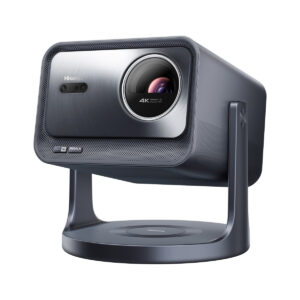 Key features
Key features
- 4K Ultra HD with HDR10+ compatibility
- JBL-tuned audio
- Smart streaming video apps included
Pros
- New generation of compact plug-and-play projectors
- AI technology assists in creating class-leading imaging
- Include DTS and Dolby audio standards
Cons
- Looks a little unconventional
This rather unusual-looking projector is designed for those who want a plug-and-play experience from something other than a mainstream brand. In the projector world, it almost looks alien, yet its specifications say something different.
Boasting stunning image quality, the C2TUK Pro 4K has adopted AI tech to upscale images to 4K. It’s also a smart projector, giving you access to streaming platforms like Netflix, Disney+, and Prime Video. And gamers will be happy to hear that FIFA+ is also included.
Audio-wise, this projector boasts DTS Virtual X and DTS HD audio sound formats. Essentially, it’s a one-box solution. Placing it 2m away from the wall or screen brings 100” of supersize visual enjoyment, and yes, it might not be the cheapest, but you get the premium quality you pay for!
2. Hisense PX3 PRO 4K Laser Cinema TriChroma Projector
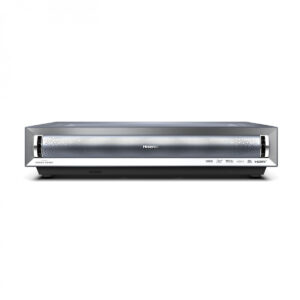 Key features
Key features
- 3000:1 contrast ratio
- Harman Kardon sound system
- 80-inch to 150-inch projected image
Pros
- Sharp 4K picture with high contrast
- Large screen projection in a compact space
- Built-in streaming apps and premium sound
Cons
- Blacks could be deeper
Only one ultra-short throw projector makes it into our lineup of the best projectors for home cinemas – the Hisense PX3-Pro 4K Laser Cinema TriChroma Projector. It projects up to a 150-inch screen while only needing 72 cm of space from the wall. And thanks to a 3000:1 contrast ratio, the TriChroma laser technology ensures deep blacks and vibrant colours for a sharp and immersive picture.
The built-in Harman Kardon sound system supports DTS and Dolby formats, reducing the need for external speakers. You can also effortlessly stream Netflix, Prime Video, and Apple TV, courtesy of an easy-to-navigate VIDAA U7 user interface, the same system found in Hisense’s TV range.
Whether upgrading your setup or replacing a traditional TV, this projector delivers a cinema-like experience at home.
3. XGIMI Horizon 2200LM 1080p Projector
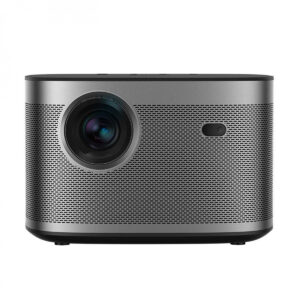 Key features
Key features
- X-Vue 2.0 image engine
- 2200 ANSI lumens enable HDR enhancements
- Hardman/Kardon audio setup
Pros
- Compact design
- Simple setup with auto screen correction
- Sound belies the projector’s small dimensions
Cons
- 200” might be a stretch in bright rooms
Newcomers to the market, XGIMI are true innovators in the projector world. Being a little different, the Horizon 2200LM uses a fixed lens, meaning you can simply place it on the coffee table at a distance of 2.5m from the screen and it’ll produce a stunning 92”+ diagonal image.
It keeps things simple, too, by incorporating Harman Kardon side-firing speakers, which help spread sound throughout the room for a more immersive audio experience – without any extra effort on your part.
Despite its compact size, it boasts an impressive 2,200 ANSI lumens of brightness, delivering a surprisingly powerful performance. This brightness also allows it to support colour standards like HDR10, even though it’s a Full HD projector.
Another great plug-and-play feature is its intelligent automatic alignment that handles the setup for you – so you can dive straight into gaming, films, or even 3D movies with minimal fuss.
4. Epson EH-TW6250 3LCD 4K Pro-UHD Projector
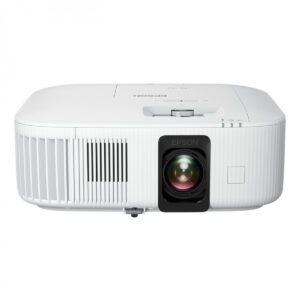 Key features
Key features
- 3LCD 4K Pro-UHD image enhancement technology
- HDCP 2.3 brings advanced gaming and 4K UHD features
- 6x zoom ratio
Pros
- Better-than-expected performance for the price
- 4k enhancement technology works very well
- Smart streaming features are a nice touch
Cons
- Design-wise, it could be a little sleeker
If you want simplicity, Epson has you covered with the EH-TW6250 3LCD 4K Pro-UHD Projector. One of the key reasons we chose this projector as one of the best for home cinemas is Epson’s clever PRO-UHD image-shifting technology, which allows you to enjoy 4K-quality films on a massive scale.
How big, you ask? With the projector lens placed just 4m from the screen, you can achieve a diagonal image size ranging from 84” to a whopping 137”, thanks to its 1.6x zoom ratio – far larger than most TVs in this price bracket can offer.
Epson has designed this projector not just for film lovers but for gamers as well. With a brightness of 2,800 lumens and a contrast ratio of 35,000:1 (under optimal conditions), it delivers vibrant, lifelike images that set a high standard.
For connectivity, it keeps things simple with HDMI inputs but also includes Android TV, making it stand out from many competing brands. Plus, with a lamp lifespan of up to 10,000 hours (according to Epson), you can expect years of hassle-free enjoyment.
5. Optoma HD28e Full HD Projector
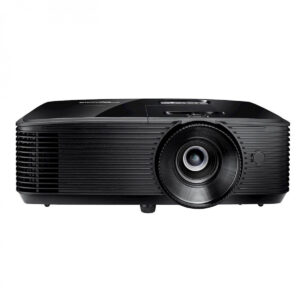 Key features
Key features
- Dynamic Black Technology
- Large screen performance
- Expected 10,000 hour lamp lifespan in eco mode
Pros
- One of the best options to join the home cinema projector family
- Great 3D playback
- Bright for difficult rooms
Cons
- Hard to fault, but the black level could be better
What’s not to like about the Optoma HD28e? It’s by no means the best projector on the market, nor is it trying to be. What it does excel at, however, is delivering everything Optoma are known for – a well-balanced projector that exceeds expectations.
Offering unrivalled performance at a fraction of the cost, it may only support 1080p, but that doesn’t hold it back. With a powerful 3,800 ANSI lumens, it delivers impressive brightness, and thanks to REC.709 support, it offers vibrant colour reproduction. Being a DLP projector, it’s also well-suited for gaming.
Lightweight and easy to mount on the ceiling, it’s a hassle-free option. Its high brightness level means you don’t need to be as strict with lighting control as you do with many other projectors. It’s a true workhorse – doing exactly what it promises, offering an honest representation of home cinema, and providing a solid foundation to build on.
That’s why I couldn’t overlook the Optoma HD28e as one of the best projectors for home cinemas. It gets so much right, a testament to Optoma’s long-standing commitment to producing real-world home cinema projectors.
6. Optoma HZ40HDR Full HD Laser Projector
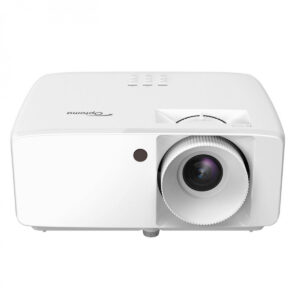 Key features
Key features
- Laser light tech with a 20,000-hour lifespan
- 300” maximum screen ability
- HDR colour standard reproduction
Pros
- One of the most affordable laser projectors
- Bright enough for 3D playback
- Ultra-low input lag @ 8.6ms making it perfect for gamers
Cons
- Sound quality could be improved
Another Optoma projector makes the list, and while it might seem like favouritism, the truth is that Optoma is one of the longest-standing home cinema brands – often setting the standard that others follow.
The Optoma HZ40HDR is another 1080p projector, but what sets it apart is its use of laser light technology. With a lifespan of 20,000 hours before brightness drops to 50%, and a further 10,000 hours before the laser reaches the end of its life (according to Optoma), it offers remarkable longevity.
Capable of projecting onto a screen up to 300” diagonally, it requires a room large enough to accommodate a throw distance of over 10 metres. However, if you’re looking to enjoy a more typical screen size, this projector delivers Optoma’s signature quality without compromise.
With 4,000 lumens of brightness, 3D playback, and Optoma’s Amazing Colour technology – designed to mimic HDR standards – it brings colours to life with impressive vibrancy. Like many Optoma projectors, it also excels at gaming, and the Optoma HZ40HDR is no exception.
7. Epson EH-LS12000 4k Laser Projector
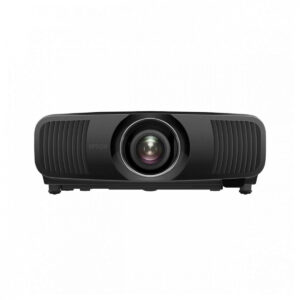 Key features
Key features
- Supports HDR10+ playback
- Motorised zoom and lens shift
- Memory zoom feature allows constant height projection
Cons
- At its price point, rivals are hard to find
- One of the most versatile projectors on the market for positioning
- 20,0000 hours usage before laser dims to 50%
Pros
- Some might find it a little large for living rooms
Even though the Epson EH-LS12000B isn’t the latest generation, there’s a good reason it remains one of the best projectors for home cinemas – this model marked the point where Epson firmly established itself as a mainstream brand in laser light technology.
The model it replaced, part of the EH-TW9x00 series, was regarded as one of the best projectors of its time, with only higher-end models from JVC and Sony offering notable competition. The EH-LS12000 was a bold move by Epson, but it paid off – massively.
The LS12000 retained all the key features of its predecessor while delivering significant improvements in both colour accuracy and shadow detail – clear benefits of laser technology. However, maintaining brightness while enhancing black levels was an unexpected yet highly welcome upgrade.
Like many 4K projectors, the Epson EH-LS12000 uses image-shifting technology to achieve a 4K pixel count. It pairs this with cutting-edge hardware, including support for 4K HDR10+. Much like the Optoma, it delivers that magic 8.3 million pixel count – something older models lacked.
If I were in the market for a new projector, this would be at the top of my list.
8. Optoma UHZ55 4K UHD Laser Projector
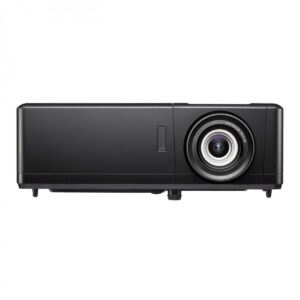 Key features
Key features
- True cinema-like colour reproduction
- 3 million pixels provide 4K UHD performance
- Built-in Android launcher
Pros
- Grassroots design and laser technology are a perfect blend
- 4K image-shifting technology delivers great results
- Lens shift is always welcome on a DLP projector
Cons
- Can sound noisy when used in its brightest setting
Optoma is one of the few brands offering a strong selection of 4K projectors, utilising either a 0.47 or 0.67 Digital Micromirror Device (DMD) chip. These tiny chipsets make a big difference if you want the best image quality. While most models, including the UHZ55, use the 0.47 chipset, this particular projector features the latest version for enhanced performance.
It delivers up to 8.3 million pixels, achieving true 4K UHD resolution through pixel-shifting technology. Additionally, its HDCP certification allows it to support HDR10 and Hybrid Log Gamma (HLG) HDR content, outperforming many of its lower-tier counterparts.
As one of the few DLP projectors with lens shift, the UHZ55 also offers an excellent throw ratio, setting it apart from the typical DLP family. It can project a screen size ranging from 92” to 120” from just 3.25m away, providing flexibility in placement.
Thanks to its exceptional 4K image reproduction and versatility, the UHZ55 easily earns its place among the best home cinema projectors, delivering far more than many of its rivals.
9. JVC DLA-NZ500 Native 4K Laser Projector
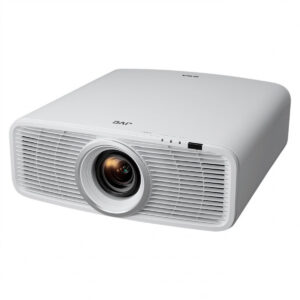 Key features
Key features
- X3 second-generation native 4K D-ILA panels
- Naturally superior grayscale spectrum
- Laser light engine with a 20,000-hour lifespan
Pros
- Combines laser, native 4K, and six-axis colour management
- New chassis design makes it more user-friendly
- Class-leading picture
Cons
- For those with a budget constraint, this level of quality is out of reach
Simply put, the DLA-NZ5000 is one of the hottest models of 2025, and anyone serious about projection cannot ignore it. Despite being JVC’s entry-level D-ILA projector, it boasts a native 4K display combined with laser light technology.
It features a newly designed chassis that is more room-friendly. This redesign has also allowed JVC to improve ventilation by altering the airflow direction, making the projector far easier to position than its larger counterparts.
JVC has made some compromises with the DLA-NZ500, such as reducing the zoom range from 2x to 1.6x. However, this minor change does little to diminish its appeal, as no competing model comes close to what it offers across the board.
Two years ago, if you’d asked me whether JVC could produce a model like this at this price point, I would’ve been sceptical. Yet here we are in 2025 with a projector that performs far beyond what its price tag suggests. Yes, JVC’s higher-end models are even better, but anything below this will struggle to compete.
10. Sony Bravia 8 (VPL-XW6100) Native 4L Laser Projector
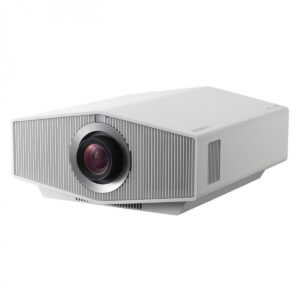 Key features
Key features
- 120hz refresh rate
- Upsamples low-resolution footage
- Achieves over 95% DCI-P3 colour space
Pros
- Sony’s XR technology comes of age with the 2025 Bravia Projectors
- 10x zoom ratio offers class-leading positioning, outclassing all competitors
- Includes Sony’s All Range Crisp Focus Lens as standard
Cons
- No 8K offering to rival the competition
As the brand that pioneered home cinema projectors, Sony has proven it can still compete – unlike many early adopters that have since faded into obscurity.
Like JVC, Sony employs similar technology to produce its images, though it refers to its system as Silicon X-tal Reflective Display (SXRD) – part of the LCoS family, much like JVC’s D-ILA projectors.
At its price point, the Sony Bravia 8 is a masterclass in projection technology. It delivers exceptional black levels, shadow detail, and vibrant yet natural colours that never feel oversaturated. It achieves all of this with Sony’s signature style – offering a distinct visual experience rather than attempting to imitate its competitors.
At this level, there are no “bad” projectors – only different ones that redefine what’s possible. These models can genuinely rival professional cinema setups, delivering an experience that TV manufacturers can only dream of. Perhaps that’s why Sony has remained in the projector industry for so long – they understand that nothing else can replicate the performance of a true home cinema projector.
11. JVC DLA-NZ900 8K Laser Projector
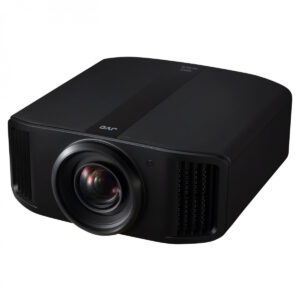 Key features
Key features
- Industry-standard 100mm all-glass optical lens system
- 8K e-shiftX technology
- BLU-Escent laser light source
Pros
- Shows OLED TVs what films should look like
- Frame Adaptive HDR brings HDR to life
- Nothing gets close to its black levels in the right rooms
Cons
- Needs the right level of electronics
When JVC first entered the market with the HD1 and later the HD100, it revolutionised home cinema. A decade ago, Sim2 CX models would have held this position, but JVC has since disrupted the elite ranges of every major brand, redefining user expectations.
The JVC DLA-NZ900 is one of the few projectors in the world that can put an OLED TV to shame – it’s that impressive. Of course, it requires the right environment and room conditions, but this isn’t just another display. It doesn’t just rival home theatre setups – it surpasses them.
This projector delivers 8K-quality visuals and features a memory zoom function for constant height projection. With a simple button press, it adjusts the image size dynamically, ensuring a seamless transition between aspect ratios.
Words can only capture so much, but those who have had the chance to experience it in action will testify to its brilliance. And they’ll also be the first to warn you: if you can’t afford it, don’t even look at it – because once you do, it’ll be hard to settle for anything less.
Laser vs. lamp
Is laser really all it’s cracked up to be? One undeniable advantage of laser projectors is avoiding the hassle of replacement lamps. The market is flooded with third-party and refurbished options, making it difficult to find a genuine lamp unless purchased from an authorised dealer.
Beyond that, laser technology offers several key benefits. Lifespan, power efficiency, brightness, colour accuracy, and overall cost all favour laser projectors, leaving traditional lamp-based models looking increasingly outdated.
The best laser projectors usually boast a lifespan of around 20,000 hours while retaining 50% of their brightness. In comparison, a lamp-based projector would typically require around five lamp replacements over the same period. However, lamp projectors are more affordable in their initial cost, and there’s a much greater variety on the market.
Want to explore the differences in more depth? Check out our laser projectors vs. lamp projectors guide, where we take a closer look at how these technologies compare.
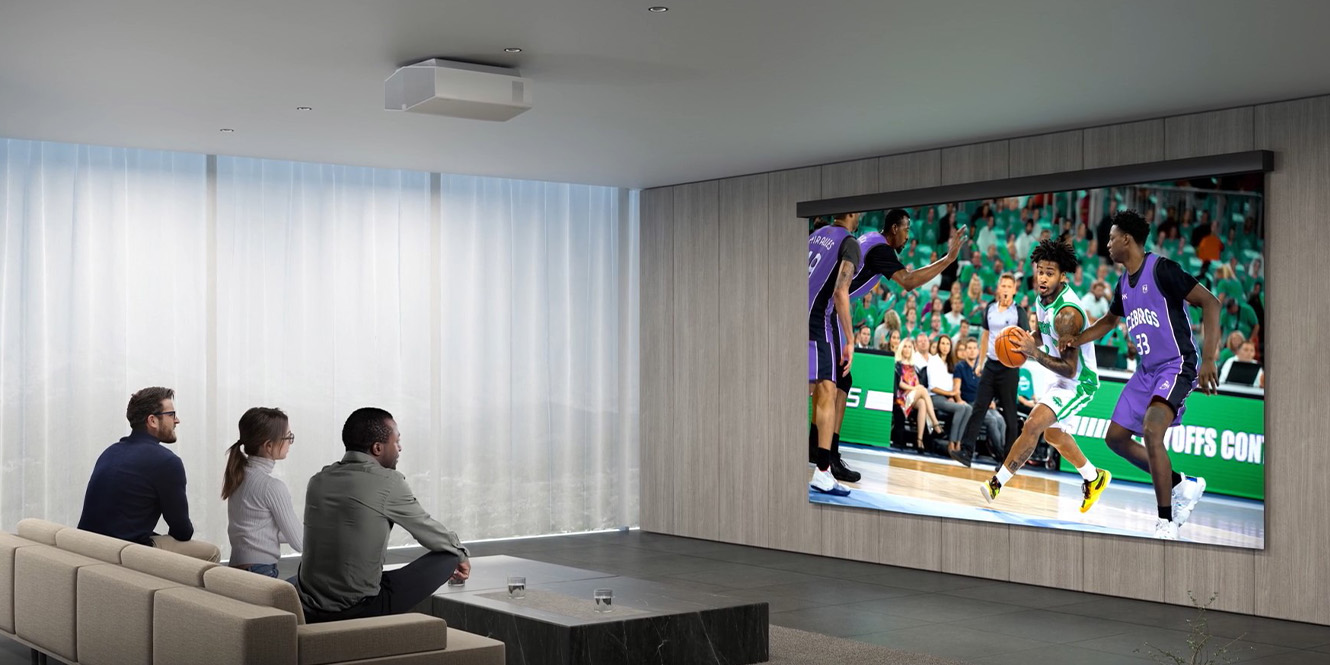
Resolution explained
When I first started working with home cinema projectors, a resolution of 1024x576p was standard, with only the very best models reaching the magic 1280x720p mark.
Once 1920x1080p Full HD content became widely available – thanks in part to the Blu-ray vs. HD DVD war and the introduction of digital HDMI connections – projector technology advanced rapidly. Before long, all major brands were offering at least one Full HD projector.
One thing that quickly became evident when watching content on a large projected screen was the importance of resolution and bitrate. Standard Definition (SD) content appeared much softer and less detailed compared to higher resolutions.
The numbers back this up – SD content typically peaks at around 6Mbps, while High Definition (HD) reaches 25Mbps. Ultra HD (4K) takes this further with bitrates of up to 50Mbps, and 8K content can average around 80Mbps. To fully benefit from these higher resolutions, you’ll need HDMI 2.2 support and Ultra High-Speed HDMI cables, such as Ultra96, to handle the increased bandwidth.
Why does this matter for projectors? With a 120” diagonal screen and a closer seating position, image quality is governed by the “screen width-to-seating distance ratio.” Lower-resolution projectors struggle in this scenario, as their reduced pixel density becomes more noticeable, negatively impacting the viewing experience.
Higher-resolution projectors overcome this limitation, allowing you to maximise your home cinema screen size without sacrificing picture quality – regardless of your room’s dimensions.
How to choose the best projector for you
There are a few key factors to consider when choosing the best projector, and the first is the type of home cinema projector: ultra-short throw, short throw, or portable.
The easiest way to decide is by looking at placement. If your room has enough space, a short-throw projector is usually the best option. However, if space is limited, an ultra-short throw model is the better choice. If you only plan to use the projector occasionally and need to store it away when not in use, a portable projector is the ideal solution.
Next is resolution, and in the world of projection, things aren’t always as they seem. Resolutions like 1080p, 4K, and Native 4K are all common, but there are important differences. At the mid-range level, 1080p or 4K projectors often use pixel-shifting technology to simulate Ultra HD quality. However, at the premium level, you’ll find true Native 4K projectors, which achieve this resolution without digital enhancements.
When choosing projector technology, you’ll frequently come across terms like DLP, 3LCD, SXRD, and D-ILA. Each has its own advantages and considerations. For a more in-depth look, I recommend reading our article, What Projector Should I Buy?, where I cover these technologies in detail. The guide also explores projection screens, which play a crucial role in achieving the best possible image quality.
I cannot stress enough the importance of the room environment, particularly lighting, when choosing the best projector for a home cinema. If your room has a lot of windows and you cannot manage the lighting, no projector will compete with natural daylight. In that case, a large flat-screen TV would be a more practical alternative.
However, if you can control the lighting, a projector creates a home cinema experience that is simply unmatched. The depth and natural quality of the image are key reasons why projectors remain the preferred choice for those seeking the best display. At almost every level, projection technology continues to outperform traditional TVs.
With an ultra-short throw projector, the throw distance will typically be within a foot, while a short-throw projector requires a bit more calculation. However, don’t let this overwhelm you – if you need help, feel free to ask in the comments below. To choose the right projector, you first need to determine where it will be positioned in your room.
A simple calculation, recognised by cinema standards, is outlined below. To use it, you’ll need to determine your viewing position – referred to as the “main seating position” – and measure the distance from there to the projection screen. This allows you to find the optimal screen size for your room.
Screen width calculation
- Recommended: Screen width = Main seating position ÷ 2
- Alternative: Screen width = Main seating position ÷ 3
Diagonal screen measurement
- Diagonal screen size = Screen width x 1.1474
Note: If this is your first experience with home cinema projection, keep in mind that additional components will be required. This includes an AV receiver, a surround sound speaker setup such as 5.1.2 or 7.2.4, and the necessary cabling, as projectors typically function as display-only devices.

FAQs
What brand of projector is best?
If you’re looking for a projector with the best value for money, Optoma offers the most for your budget. For top-tier performance, where price is no concern, JVC leads the way. And for everything in between, Epson is the go-to choice.
Which home projector is best?
The best home projector depends entirely on your room setup and budget. The JVC DLA-NZ900 is the top choice for ultimate performance, but the Epson EH-Q1000B might be the best option for your specific needs. The right projector is the one that fits your space, requirements, and budget.
Is a 4K projector worth it?
If you want to watch 4K movies, a 4K projector is well worth it. The increased resolution delivers better brightness, sharpness, and smoother motion, thanks to the higher data capacity. And that’s before even considering HDR10, which enhances contrast and colour depth. So yes, a 4K projector makes a noticeable difference!
Final thoughts
One thing is certain – if you’ve made it this far, you must love projectors! There’s a lot to take in, but hopefully, you’ve found an option that’s right for your setup on our list of the best projectors.
In compiling the list, I wanted to make sure we didn’t just follow the usual recommendations or mainstream publications. Instead, the options here focus on real performance, value, and what truly makes a difference in a home cinema setup.
My choices are based on a projector’s actual performance, whether it fills a gap that previously didn’t exist or exceeds expectations in an unexpected way. Sometimes, a model delivers far more than its price point suggests, and this holds true across all levels of the market.
To find out more, check out the links below.
What Projector Should I Buy? A Handy Guide to Projectors

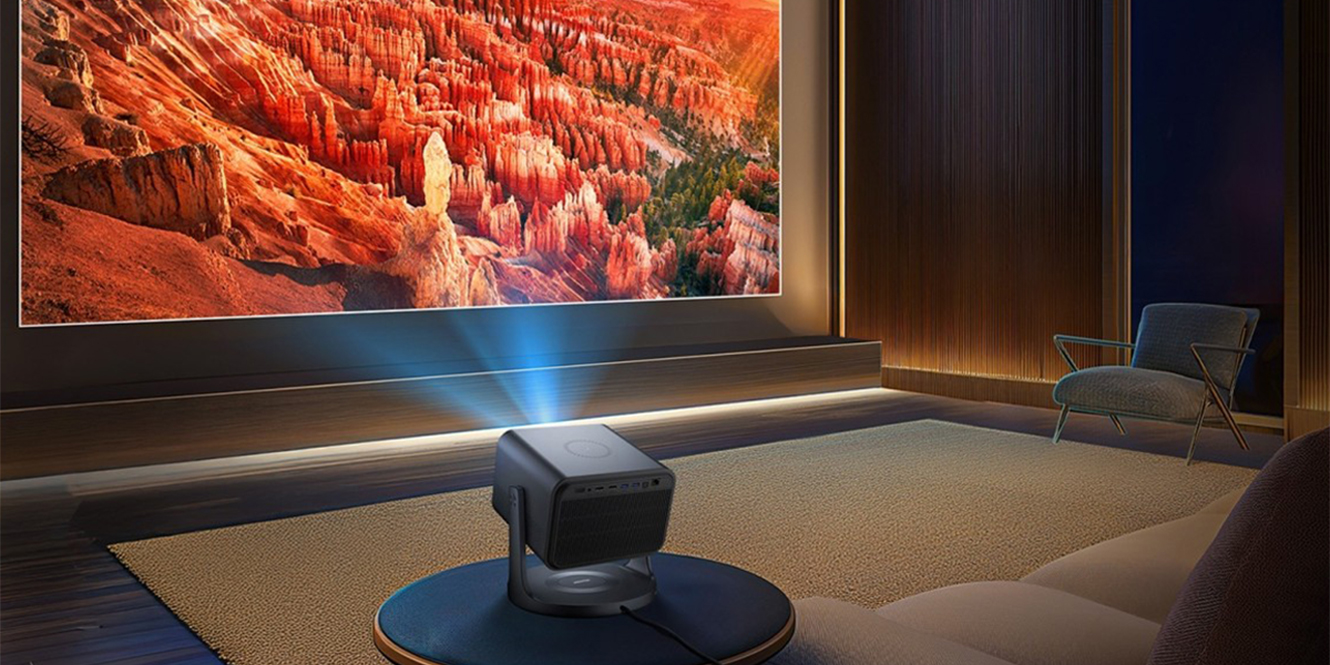
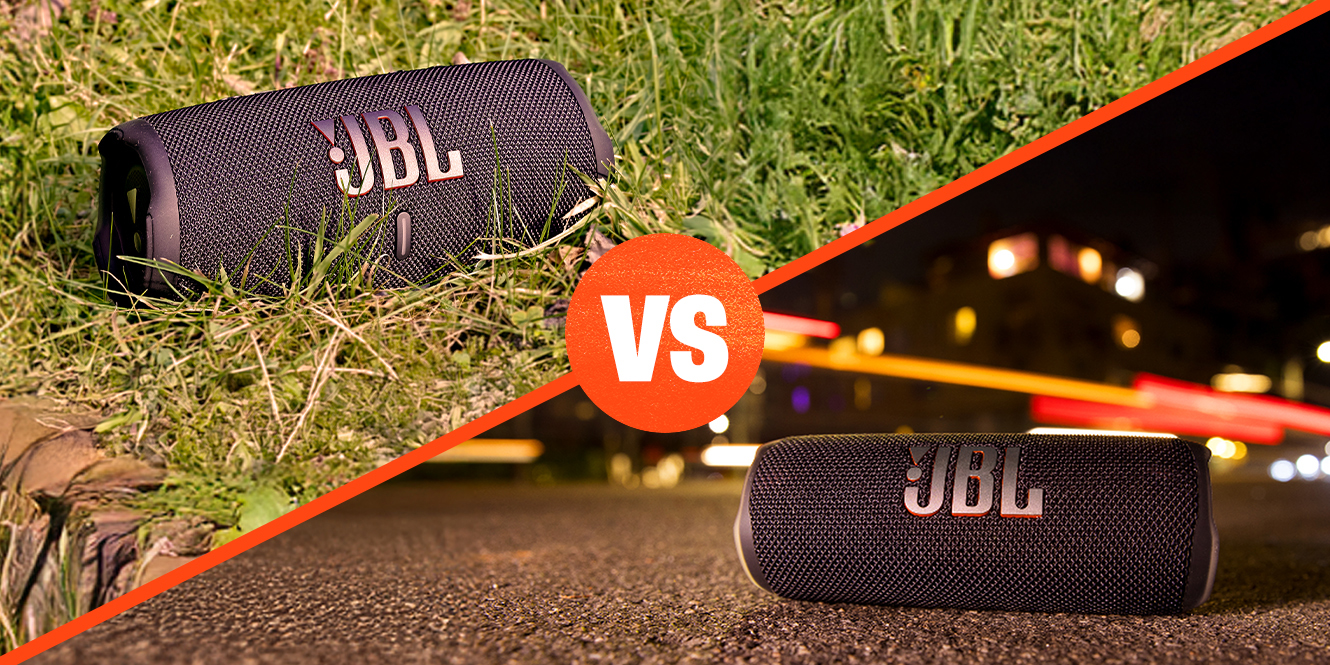



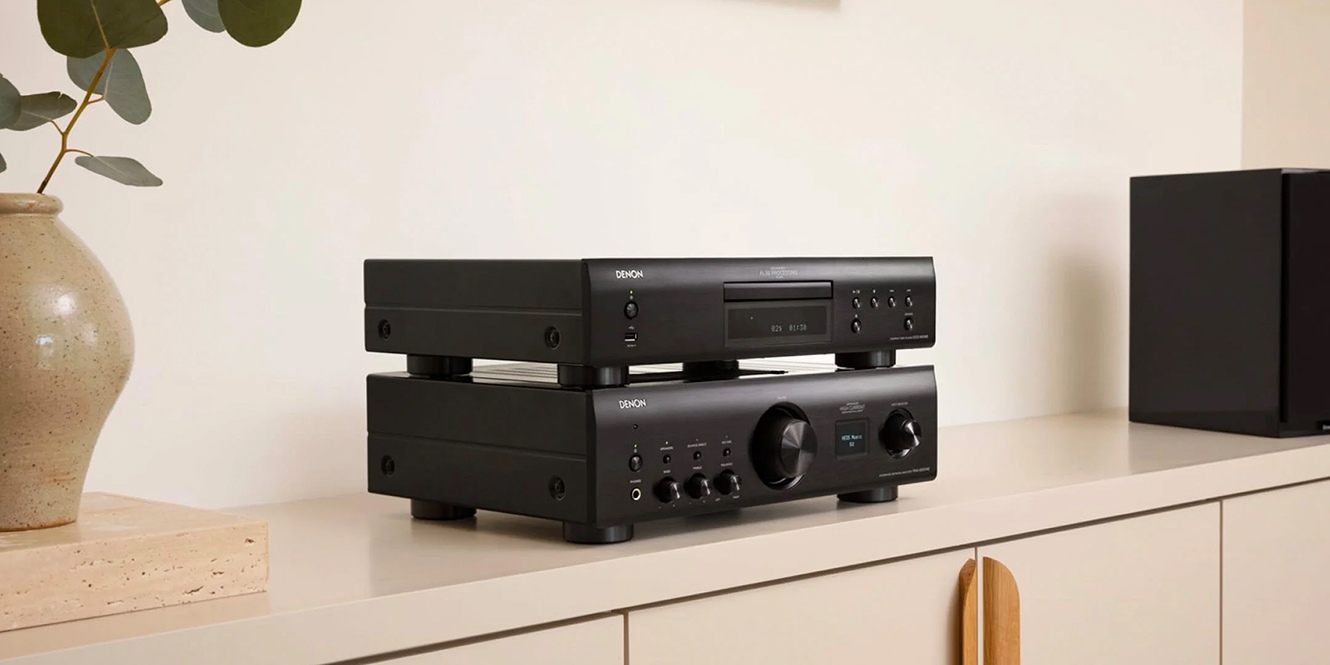



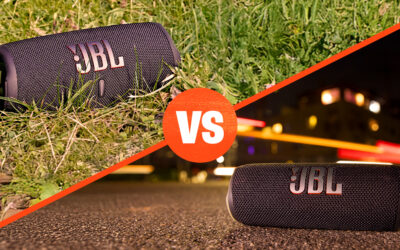
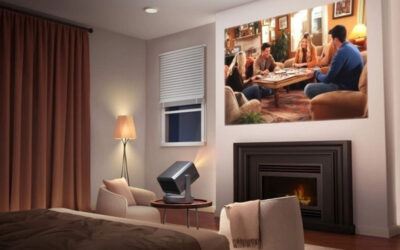

0 Comments